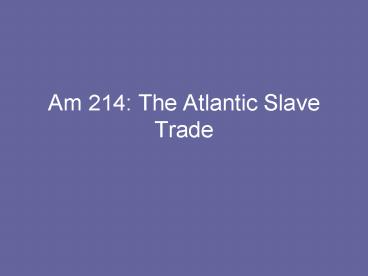Am 214: The Atlantic Slave Trade - PowerPoint PPT Presentation
1 / 51
Title:
Am 214: The Atlantic Slave Trade
Description:
Participants: African Sellers, European Buyers, American Planters, African Slaves ... Clothes, Houses, Music, Gambia 18th century. Male Circumcision Ceremony ... – PowerPoint PPT presentation
Number of Views:82
Avg rating:3.0/5.0
Title: Am 214: The Atlantic Slave Trade
1
Am 214 The Atlantic Slave Trade
2
Plan of Lecture
- Introduction Zuraras account of arrival of
slaves, Lagos, Portugal 1444 - Volumes and Dimensions of Slave Trade
- Pre Conquest Africa
- Participants African Sellers, European Buyers,
American Planters, African Slaves - The Middle Passage Olaudah Equaino
- Slave Mortality - The Brooks
- Resistance on Slave Ships
- The Slave Trade An African Holocaust?
3
Zuraras Account of West African Slaves Lagos,
Portugal 1444
- On the next day those captives, placed
together in that field were a marvellous thing to
behold, because among them were some who were
reasonably white, handsome and genteel others,
not so white, who were like mulattoes others as
black as Ethiopians, so deformed of face and body
that it seemed to those who guarded them that
they were gazing upon images of the lowest
hemisphere.
4
Volume and Destination
- Best source David Eltis, The Volume and
Structure of the Transatlantic Slave Trade A
Reassessment, William and Mary Quarterly , LVIII
(2001), 17-46 - See also D.Eltis, S. Behrendt, D. Richardson and
H. Klein, "The Transatlantic Slave Trade A
Database on CD-ROM" (Cambridge University Press,
1999
5
(No Transcript)
6
(No Transcript)
7
(No Transcript)
8
(No Transcript)
9
(No Transcript)
10
(No Transcript)
11
Africa Pre Conquest
12
Immense Ethnic Mix
13
Queen Nzinga and Drummers, Kongo, 1670s
14
Queen Nzinga prints
- Antonio Cavazzi (b. 1621) was an Italian priest
who from 1654 to 1667 joined the Capuchin mission
in what is today northern Angola after a visit
to Europe, he returned to Angola, particularly
the Kingdom of Kongo, where he remained from 1672
to 1677. He died in Genoa in 1678. Cavazzi made
this and other watercolors, the originals of
which are in his manuscript, located in a private
collection in Modena, Italy (see also "Cavazzi"
for other images on this website). Cavazzi's
drawings must be among the earliest known
eyewitness sketches of African life by a European
15
Soldiers, Kongo, 1670s
16
Musicians, Kongo, 1670s
17
Queen Nzinga and Entourage, Kongo, 1670s
18
Ceremonial Procession, Kongo, 1670s
19
Queen Nzinga and Entourage, Kongo, 1670s
20
Magician, Kongo, 1670s
21
African House Sierra Leone, late 17th century
22
Manioc Preparation, 1722
23
Clothes, Houses, Music, Gambia 18th century
24
Male Circumcision Ceremony
25
Coronation King of Whydah, April 1725
26
Procession of the Serpent, Whydah, April 1725
27
City of Loango, Angola, late 17th century
28
Don Alvaro, King of Kongo, receiving Dutch
delegation, 1642
29
Europeans in Slave Trade Merchants
- Merchant slave traders Pierre Cornut (banker)
Browns of Rhode Island (whalers) Richard Oswald
of London (troop provisions) Sir Alexander Grant
(planter) - Jean Barbot however unpleasant it was to be a
slave in the Americas, it was better than to be
one, or even a free man in Africa - Gerard Mellior of Nantes At bottom, the blacks
are naturally inclined to theft, robbery,
idleness and treason.
30
Europeans in Slave Trade Sailors
- Ships captains men of parts
- Surgeons
- Ordinary seamen
- John Newton The real or supposed necessity of
treating the Negroes with rigour gradually brings
a numbness upon the heart and renders those who
are engaged in it too indifferent to the
sufferings of their fellow creatures
31
The Middle Passage
- Olaudah Equaino , An Interesting narrative
- Claimed he was an African boy from Ibo region of
Nigeria, carried to America as a nine year old
boy. May have been from South Carolina. - The first object which saluted my eyes was the
sea, and a slave ship, which was then riding at
anchor These filled me with astonishment, which
was soon converted to terror, when I was carried
on board.
32
The Slave Ship
33
Selection of Slaves in Africa
34
Europeans Haggling with African Traders
35
Selection of African Slaves
36
Being Sold into Slavery
37
Slave Branding
38
Slaves loaded onto ships
39
Slaves loaded onto ship
40
Slaves on slave ship
41
Slaves on slave ship
42
The packing of Slaves
43
Slave Packing, the Brooks
44
French drawing of slave transportation
45
Slaves made to dance
46
Slave shackles
47
Slave Punishment Captain Kember
48
Slave Rebellion
49
Slave Rebellion
50
Slave Sale, America
51
The Slave Trade as an African Holocaust?
- Anne Frank Every night people are being picked
up without warning and that is awful particularly
for old and sick people, they treat them just
like slaves in the olden days If it is as bad as
this in Holland whatever will it be like in the
distant and barbarous regions they are sent to?
We assume most of them are murdered.































